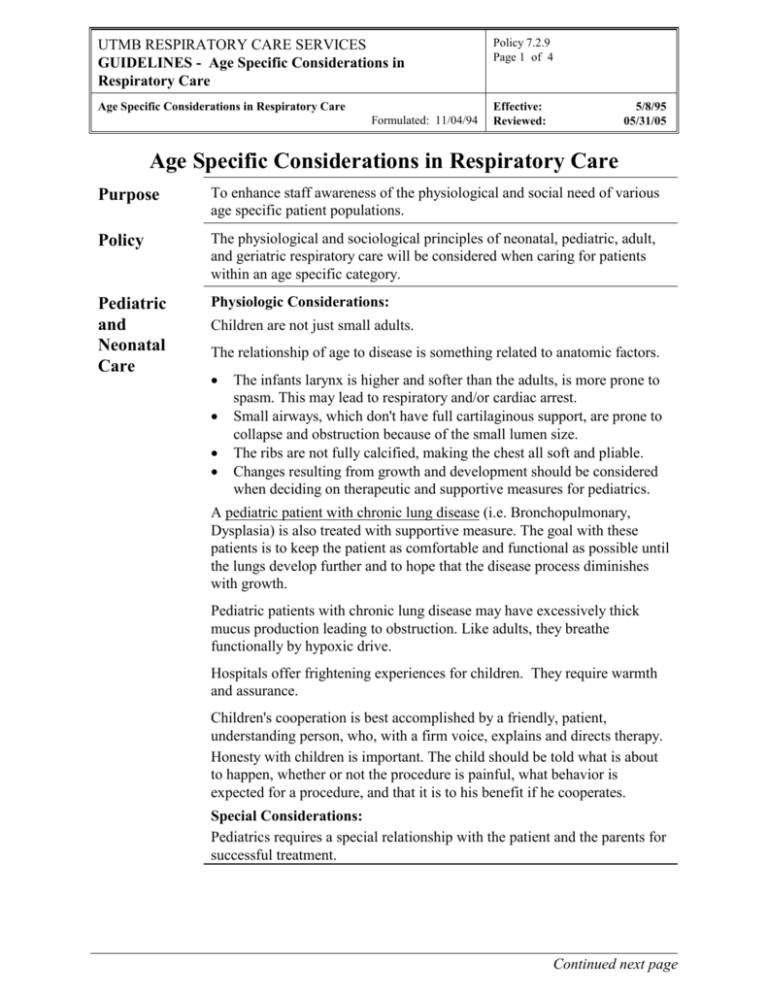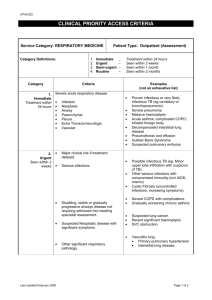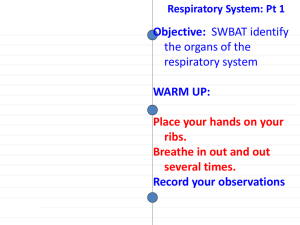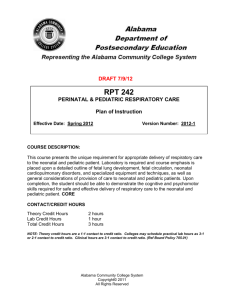Age Specific Considerations in Respiratory Care
advertisement

UTMB RESPIRATORY CARE SERVICES GUIDELINES - Age Specific Considerations in Respiratory Care Policy 7.2.9 Page 1 of 4 Age Specific Considerations in Respiratory Care Effective: Reviewed: Formulated: 11/04/94 5/8/95 05/31/05 Age Specific Considerations in Respiratory Care Purpose To enhance staff awareness of the physiological and social need of various age specific patient populations. Policy The physiological and sociological principles of neonatal, pediatric, adult, and geriatric respiratory care will be considered when caring for patients within an age specific category. Pediatric and Neonatal Care Physiologic Considerations: Children are not just small adults. The relationship of age to disease is something related to anatomic factors. The infants larynx is higher and softer than the adults, is more prone to spasm. This may lead to respiratory and/or cardiac arrest. Small airways, which don't have full cartilaginous support, are prone to collapse and obstruction because of the small lumen size. The ribs are not fully calcified, making the chest all soft and pliable. Changes resulting from growth and development should be considered when deciding on therapeutic and supportive measures for pediatrics. A pediatric patient with chronic lung disease (i.e. Bronchopulmonary, Dysplasia) is also treated with supportive measure. The goal with these patients is to keep the patient as comfortable and functional as possible until the lungs develop further and to hope that the disease process diminishes with growth. Pediatric patients with chronic lung disease may have excessively thick mucus production leading to obstruction. Like adults, they breathe functionally by hypoxic drive. Hospitals offer frightening experiences for children. They require warmth and assurance. Children's cooperation is best accomplished by a friendly, patient, understanding person, who, with a firm voice, explains and directs therapy. Honesty with children is important. The child should be told what is about to happen, whether or not the procedure is painful, what behavior is expected for a procedure, and that it is to his benefit if he cooperates. Special Considerations: Pediatrics requires a special relationship with the patient and the parents for successful treatment. Continued next page UTMB RESPIRATORY CARE SERVICES GUIDELINES - Age Specific Considerations in Respiratory Care Policy 7.2.9 Page 2 of 4 Age Specific Considerations in Respiratory Care Effective: Reviewed: Formulated: 11/04/94 Pediatric and Neonatal Care Continued 5/8/95 05/31/05 Precision and careful measurements are a necessity. Pediatric patients will require more precise observation during therapy, and evaluation than adults. Most adult principles and facts apply to pediatric respiratory care. There is usually only a difference in technique with special considerations for development, age, and size of the patient. Parental Considerations: Understanding of chronic illness prepares parents to make rational decisions when helping make care plans along with the child (if possible) and the rest of the medical team. Participating in care planning for the child is important because it helps parents overcome the initial shock, disbelief, and guilt. Adolescent Care While medical treatment of adolescents may parallel that of adults, some consideration must be given regarding the following: Recognize importance of body image. Need for privacy and confidentiality. Avoid use of condescending language. Provide feedback on health condition and allow for participation in care decisions. Be aware of potential for abuse or neglect. Geriatric Care Physiologic Considerations: Biology of Aging Aging is a complex process that involves: Biologic aging - time related changes in cells, tissues systems. Economic aging - changes in financial status. Psychological aging - changes in behavior. Social aging - acquired social habits. The following principles apply to the aging process and patient care: Organs do not age simultaneously. A given organ does not age at the same rate in different individuals. Aging begins with birth and is most noticeable beginning between ages 50 to 60 years. Conditions of the elderly usually involve multiple-organ failure. Structurally, aging causes the lungs to: Decrease in weight as a result of loss of mass. Change color from yellowish-pink to gray with patches of dark pigmentation. Continued next page UTMB RESPIRATORY CARE SERVICES GUIDELINES - Age Specific Considerations in Respiratory Care Policy 7.2.9 Page 3 of 4 Age Specific Considerations in Respiratory Care Effective: Reviewed: Formulated: 11/04/94 Geriatric Care Continued 5/8/95 05/31/05 Develop emphysema - loss of tissue elasticity and alveolar walls. Lose lung surface area by approximately 0.27 square meters or 2.9 square feet per year from age 30 to 74. Have less efficient alveoli as a result of loss of collagen in relationship to elastin. Lose functional pulmonary capillaries as alveoli are destroyed. Anatomically, the chest undergoes the following changes as a result of aging: Kyphosis - curvature of the spine caused by changes in elderly persons' posture and muscle tone. Increased rigidity of the rib cage caused by loss of muscle and ineffective mechanics, combined with calcification of bones and rigidity and/or loss of cartilage resulting from arthritic changes. Increased rigidity of trachea and connecting airways caused by loss of muscle tone and pathologic conditions. Increased anterior/posterior diameter and barrel chest appearance in patients with chronic obstructive lung disease. Possible functional effects of aging on the lungs are listed below: Exhalation is more pronounced than inspiration. Abnormal breathing patterns such as Cheyne-Stokes are more common. Tidal volume remains unchanged. VD/VT is increased from 20:25% at a rate of 2.4% every 10 years. Minute volume remains unchanged, although efficiency is decreased. Vital capacity is decreased 40% beginning with age 20 through 85 years. Residual volume is increased. Maximum ventilatory volume is decreased from 165L/min at age 25 to 75 L/min at age 85. PaCO2 does not change with age, except with a related pathologic condition. PaO2 decreases with age from approximately 100 mm hg at age 20 to 79mm Hg at age 80. The following changes occur with senescence: Psychomotor ability and ability to adjust to environment fails, resulting in falls and infections. Malnutrition results from loss of taste, teeth and poor diet. Social activity is decreased as a result of the death of friends. Mental health and memory may deteriorate. Continued next page UTMB RESPIRATORY CARE SERVICES GUIDELINES - Age Specific Considerations in Respiratory Care Policy 7.2.9 Page 4 of 4 Age Specific Considerations in Respiratory Care Effective: Reviewed: Formulated: 11/04/94 References 5/8/95 05/31/05 HCPro, Inc. Age Specific Competencies, Envision, 2003, http://www.envisioninc.net/ Lee Abramo, MSN, RN Age-Specific/Transcultural Competencies for Healthcare Providers, Website Update: May 23, 2003, http://www.agespec.com/ Francine Wolgin, Advanced Skills and Competency Assessments for Caregivers, Prentice Hall March 1999









